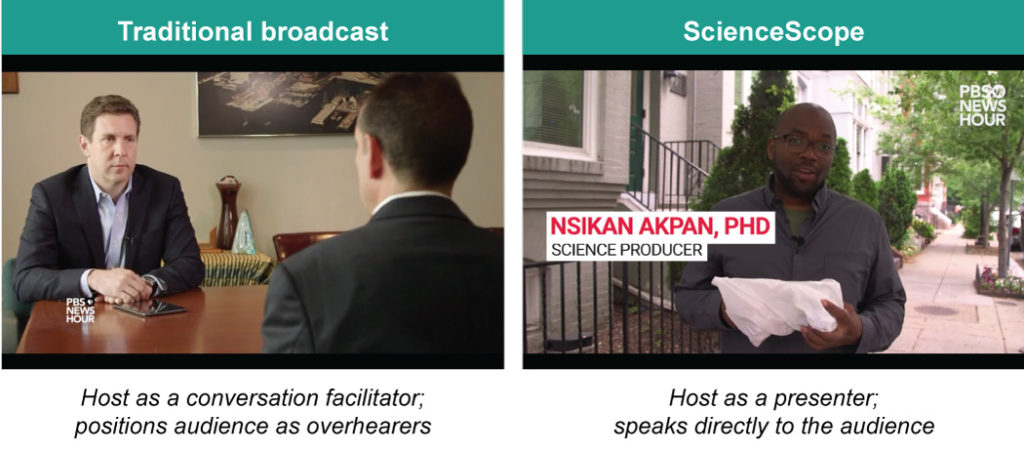PBS NewsHour: Experiments in Transmedia
Subtitle here

Background
PBS NewsHour and Knology invited us to serve as third-party evaluators for the multi-year National Science Foundation grant, Experiments in Transmedia. We worked with the project team to replicate findings, track progress, and analyze STEM content to assess the outcomes of this funding on PBS NewsHour and the broader journalism landscape. This type of research can help other journalistic efforts learn new production and distribution strategies to improve engagement among their audiences and ways to partner to create more engaging content.
PBS NewsHour wanted to increase their capacity to reach Early Career Adults with Science, Technology, Engineering, and Math (STEM) content. They were awarded a 4-year National Science Foundation grant in collaboration with Knology to develop and undertake audience research, experiment with new media techniques, and assess which methods are most effective for improving STEM literacy among young adults. An additional goal was to explore the capacity for real-time collaboration between a research organization and a newsroom.

Our Role
We served as an external reviewer for the grant and conduct a summative evaluation. To assess both process and outcomes, our mixed-methods approach consisted of:
- Pre-Post Interviews with members from the NewsHour and Knology teams (during Years 1 and 4 of the grant) to understand goals and expectations (Year 1) and the extent to which the project achieved these goals (Year 4).
- Content Analysis of NewsHour’s Year 2 and Year 3 STEM content to better understand production trends. We coded 522 stories for media platform and channel, frame, content/topic, subject, information type, and framing strategy (i.e., episodic vs. thematic).
- Online Experiment examining ECAs’ and non-ECAs’ preferences for story content (natural science, social science, or non-science) and platform (PBS NewsHour website or social media), as well as impacts on information sharing and science identity.
Synthesizing these results with the project data NewsHour and Knology provided to us, we assessed the extent to which NewsHour increased their capacity to create transmedia content.
Achievements of this grant were identified across four areas: capacity, production, research, and dissemination. These four outcomes all reinforced each other as part of this project’s iterative process. For example, building capacity increased the amount and variety of STEM content produced. These production changes then aided Knology’s research activities, which, in turn, increased NewsHour’s capacity and informed production strategies. This process allowed for rich learning experiences among both the NewsHour and Knology teams, and provided opportunities to disseminate research findings to both academic and journalist audiences.

Findings
The collaborative work between Knology and NewsHour created substantial capacity building opportunities for content creators within and beyond the PBS system. NewsHour staff experimented with new methods for producing and distributing STEM media content—building internal capacity—and then disseminated insights to colleagues and peers about program effectiveness, efficiency, and feasibility of various tools to increase young adults’ interest and engagement with STEM.
Regarding content production, not only did the number of STEM stories significantly increase between Years 2 and 3 (p < .05), but the proportion of STEM stories originating from “non-traditional” media platforms (i.e., social media) also increased significantly from Year 2 (7.7%) to Year 3 (16.7%; p < .001). The most notable case of transmedia storytelling was a week-and-a-half long series on the opioid epidemic called America Addicted.
Throughout the grant, NewsHour and Knology’s research yielded a variety of contributions for both knowledge advancement and the provision of advances in informal STEM learning for society writ large. The research proposes a variety of production strategies that may be more effective than current strategies at fostering audience engagement—particularly among ECAs. Additionally, the process itself exemplifies a real-time collaboration between researchers and practitioners and demonstrates the compelling media that this sort of collaboration can yield.
Opportunities & Future Directions
Overall, the outcomes of this project served to both support a greater understanding of STEM engagement through journalism and provide a case study of how this work can be done in practice. We hope to see more work like this in the future media landscape.
Recommendations for similar initiatives in the future include:
- Media organizations should consistently try new production and distribution strategies to improve engagement among their audiences
- Researchers and journalists should partner to evaluate production/distribution strategies and create more engaging content
- Researchers/journalists should share their findings with others within and across disciplines.
Testimonials
Resource Library
Share This Project
Intrigued? Let’s Chat!
